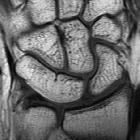lunotriquetral coalition























Lunotriquetral coalition is the most common type of carpal coalition and represents a congenital fusion of the lunate and triquetral bones of the carpus.
Epidemiology
Lunotriquetral coalition is the most common type of carpal coalition with a prevalence of 0.1%. It is more common in females (F:M = 2:1) and African Americans.
Clinical presentation
Whilst osseous coalitions of the lunate and the triquetrum are known to be asymptomatic, fibrocartilaginous lunotriquetral coalitions can present as an uncommon cause of ulnar-sided wrist pain often due to the pseudarthrosis or a post-traumatic disruption .
Pathology
- coalition may be fibrous, cartilaginous or osseous
- commonly bilateral
Carpal coalitions can follow an autosomal dominant route of inheritance
Classification
de Villiers classified lunotriquetral coalition into four types :
Radiographic features
Plain radiograph
- coalition of the lunate and triquetrum
- may be accompanied by a widened scapholunate interval
Treatment and prognosis
Most commonly an incidental finding. May occasionally be the cause of chronic wrist pain (especially in types 1 and 2 ) and, of course, can be fractured.
Siehe auch:
und weiter:

 Assoziationen und Differentialdiagnosen zu Lunotriquetrale Koalition:
Assoziationen und Differentialdiagnosen zu Lunotriquetrale Koalition:

